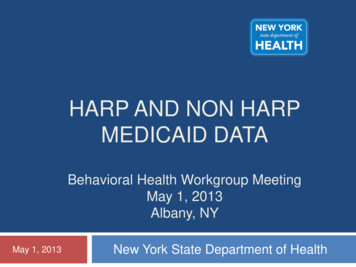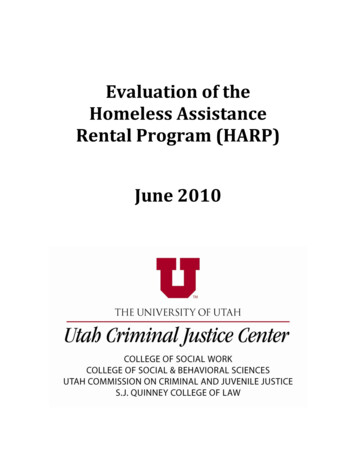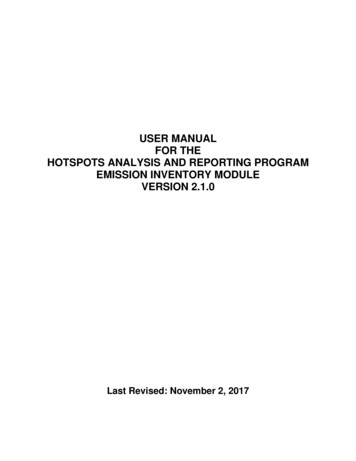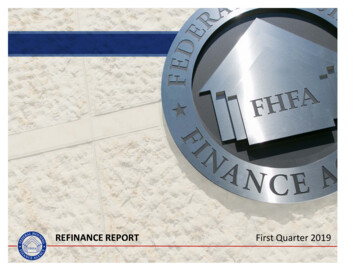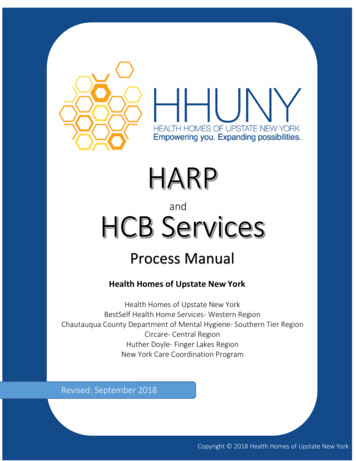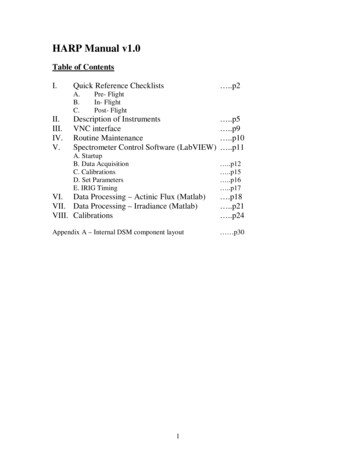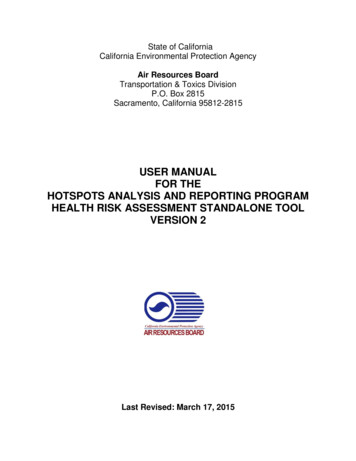
Transcription
State of CaliforniaCalifornia Environmental Protection AgencyAir Resources BoardTransportation & Toxics DivisionP.O. Box 2815Sacramento, California 95812-2815USER MANUALFOR THEHOTSPOTS ANALYSIS AND REPORTING PROGRAMHEALTH RISK ASSESSMENT STANDALONE TOOLVERSION 2Last Revised: March 17, 2015
TABLE OF CONTENTS1.OVERVIEW . 1a.How is this User Guide Organized?. 2b.What can the Risk Assessment Standalone Tool (RAST) do? . 3i.Pollutant Exceptions: Asbestos, Diesel PM, & Inorganic Lead . 62.GETTING STARTED & PROCESS OVERVIEW . 8a.System Requirements . 8b.Installing HARP 2 RAST . 8c.Opening the Program . 9d.Getting Familiar with the Program . 9e.Training . 103.USER INTERFACE OVERVIEW. 10a.Main Screen . 10b.Main Menu Options . 11c.Tab Pages . 12d.Help Resources . 144.STEP 1: ENTERING POLLUTANT CONCENTRATIONS . 14a.Manually Adding Pollutant Information . 14i. Group1 & Group2 (Optional) . 16ii. POLID/CAS . 16iii. Average & Maximum Concentrations . 18iv. Pathway Receptors . 18b.Importing Pollutant Information Using a CSV File. 20c.Sorting and Editing Data . 23d.Viewing Pollutant Health Values . 245.STEP 2: SELECTING RISK SCENARIO & CALCULATING RISK . 256.STEP 2: SELECT RISK SCENARIO . 26a.Choosing the Analysis Type . 27b.Determining the Receptor Type . 29c.Exposure Duration for Cancer Risk Assessments . 31
i. ADVANCED FEATURE: User Defined Start Age and Duration . 33d.7.Intake Rate Percentile . 33STEP 2: SELECT PATHWAYS TO EVALUATE & ENTER SITE SPECIFICPARAMETERS . 35a.Pathways to Evaluate . 35i.Activating and Deactivating Pathways . 35ii.Choosing Pathways to Evaluate . 38iii.Deposition Rates . 40iv.ADVANCED FEATURE: Changing the Exposure Frequency. 41b.Inhalation . 41i.Time at Home. 42ii.ADVANCED FEATURE: Time at Residence . 42iii.8-Hour Breathing Rates . 42iv.ADVANCED FEATURE: Breathing Rates . 43v.Adjustments for Worker or 8-Hour Chronic Risk . 43vi.GLC Adjustment Factor . 44vii.Exposure Frequency . 45c.Soil . 46i.ADVANCED FEATURE: Soil Intake Rates . 47ii.ADVANCED FEATURE: Soil Accumulation Period . 47d.Dermal . 48i.Climate . 48ii.ADVANCED FEATURE: Dermal Loading Rates . 50e.Mother’s Milk . 50i.ADVANCED FEATURE: Mother’s Milk Intake Rates . 51f.Drinking Water . 52i.Surface Area, Water Volume, & Volume Changes . 53ii.Fraction of Drinking Water from Contaminated Source . 53iii.ADVANCED FEATURE: Average Human Water Consumption. 54g.Fish . 54i.Surface Area, Water Volume, & Volume Changes . 55ii.Fraction of Fish Consumed from Contaminated Source . 56iii.ADVANCED FEATURE: Average Human Fish Consumption . 57
h.Homegrown Produce . 57i.Leafy, Exposed, Protected, & Root Produce . 58ii.Fraction of Produce Consumed from Contaminated Source . 59iii.ADVANCED FEATURE: Human Produce Consumption Rate . 60i.Beef & Dairy . 60i.Fraction of Beef & Dairy from Contaminated Source . 61ii.Beef & Dairy Cow Drinking Water . 62iii.Beef & Dairy Cow Diet . 64iv.ADVANCED FEATURE: Human Beef & Dairy Consumption Rates . 64j.Pig, Chicken, & Egg . 65i.Fraction of Pig, Chicken, & Egg from Contaminated Source . 66ii.Pig, Chicken, & Egg Drinking Water . 66iii.Pig, Chicken, & Egg Diet . 68iv.ADVANCED FEATURE: Human Pig, Chicken, & Egg Consumption Rate . 698.STEP 2: CALCULATE RISK . 709.STEP 3: VIEW RISK RESULTS . 74a.Navigating Risk Tables . 74b.Cancer & Noncancer Columns . 75c.Target Organ Systems . 77d.Cancer Risk Results Table . 79e.Chronic, 8-hour, & Acute (Noncancer) Risk Results Tables . 80f.Load, Group, View, & Export Risk Data . 83
REFERENCESOEHHA (2015). The Air Toxics Hot Spots Program Guidance Manual for Preparation ofHealth Risk Assessments. Available online at http://www.oehha.ca.gov.
APPENDICESAPPENDIX A: Glossary of Acronyms and Definitions of Selected Terms. 92APPENDIX B: Consolidated Table of OEHHA/ARB Approved Risk Assessment HealthValues . 99APPENDIX C: Table of Specific Pathways to be Analyzed for each MultipathwaySubstance . 111APPENDIX D: How to Format a CSV File for Import . 112APPENDIX E: How to Use the Command Prompt to Calculate Risk from Data Inputtedin Another Program . 120
LIST OF TABLESTable 1-1. Summary of Functions of the Three Programs in HARP 2 . 4Table 1-2. Pollutants with OEHHA/ARB Approved Risk Assessment Health Values . 5Table 3-1. Main Menu Options. 12Table 6-1. Analysis Types. 28Table 6-2. Receptor Types . 30Table 6-3. Exposure Duration Options for Cancer Risk Assessments . 32Table 6-4. Recommendations for Exposure Duration for Individual Cancer RiskAssessments at the MEIR and MEIW . 32Table 6-5. Intake Rate Percentile Methods . 34Table 7-1. Specific Pathways to be Analyzed for each Multipathway Substance . 39Table 7-2. Mandatory and Site/Route Dependent Exposure Pathways . 40Table 7-3. Climate Types . 50Table 7-4. Multipathway Pollutants and Uptake by Crop Type . 59Table 9-1. Cancer Risk Sum versus Noncancer Hazard Quotient . 76Table 9-2. Risk Results Column Names and Definitions. 76Table 9-3. Target Organ Systems in RAST . 78
HotSpots Analysis and Reporting Program User GuideHealth Risk Assessment Standalone ToolVersion 2March 20151. OVERVIEWThe Hotspots Analysis and Reporting Program Version 2 (HARP 2) is a software suiteused to assist with the programmatic requirements of the Air Toxics “Hot Spots”Program. This version replaces the previous version (HARP 1 series) and incorporatesthe information presented in the 2015 Air Toxics Hot Spots Program Guidance Manualfor Preparation of Health Risk Assessments. HARP combines the tools of emissioninventory database, facility prioritization, air dispersion modeling, and health riskassessment analysis. In this version, HARP 2, the modules have been separated intothree individual programs which will allow users to access any of the modulesindependently or to share information between each program. The three programs arereferred to as the Emission Inventory Module (EIM), Air Dispersion Modeling and RiskAssessment Tool (ADMRT), and the Health Risk Assessment Standalone Tool (RAST).EIM creates and manages facility emission inventory databases and calculates facilityprioritization scores. ADMRT performs air dispersion analysis in order to calculateground level concentrations (GLCs) of pollutants to evaluate potential cancer andnoncancer health impacts. RAST is a standalone tool used solely to calculate potentialcancer and noncancer health impacts. Each software has its own user document, andthis user guide will focus on RAST.HARP was created for the purpose of assisting and supporting the local California AirPollution Control and Air Quality Management Districts (districts) with implementing therequirements of Assembly Bill 2588 (AB 2588). AB 2588, known as the Air Toxics “HotSpots” Information and Assessment Act, was enacted in September 1987. Under thisAct, stationary source facilities are required to report the types and quantities of certainsubstances their facilities routinely release into the air. Emissions of interest are thosethat result from the routine operation of a facility or that are predictable, including but notlimited to continuous and intermittent releases and process upsets.The goals of the Air Toxics “Hot Spots” Act are to collect emissions data, to identifyfacilities having localized impacts, to ascertain health risks, and to notify nearbyresidents of significant risks. In September 1992, the “Hot Spots” Act was amended bySenate Bill (SB) 1731 to address the reduction of significant risks. The bill requires thatowners of significant-risk facilities reduce their risks below the level of significance.The Act requires that toxic air emissions from stationary source facilities be quantifiedand compiled into an inventory according to criteria and guidelines developed by the AirResources Board (ARB), that each facility be prioritized to determine whether a riskassessment must be conducted, that the risk assessments be conducted according tomethods developed by the Office of Environmental Health Hazard Assessment1
(OEHHA), that the public be notified of significant risks posed by nearby facilities, andthat emissions which result in a significant risk be reduced. Owners of facilities found topose significant risks by a district must prepare and implement risk reduction audits andplans within six months of the determination. Legislation states that these plans toreduce airborne toxic risk reduction measures from a facility should be completed withinfive years of the date a plan is submitted to the district. The period to implement a planmay be shortened by the district if it finds that it is technically feasible and economicallypracticable to implement a plan more quickly. The district may also lengthen the timeperiod needed to implement the plan, up to an additional five years. This may occurwhen it is determined that the facility 1) cannot meet the initial five year deadline due tounreasonable economic burden, 2) the risk reduction plan is not technically feasible, or3) a time period of longer than five years will not result in unreasonable risk to thepublic.For more information on the Air Toxics “Hot Spots” Program, please visit ARB’s websiteat http://www.arb.ca.gov/ab2588/ab2588.htm.Users of HARP 2 should have a working knowledge of air dispersion modeling, ARB’sEmission Inventory Criteria and Guidelines, and the risk assessment methods andprocedures outlined in OEHHA’s 2015 Air Toxics Hot Spots Program Guidance Manualfor Preparation of Health Risk Assessments (OEHHA Guidance Manual).HARP 2 can be used by districts, facility operators, and other parties to manage andevaluate emissions inventory data and the potential health impacts associated withthese emissions. The use of HARP 2 promotes statewide consistency, increases theefficiency of evaluating potential health impacts, and provides a cost-effective tool fordeveloping facility health risk assessments.HARP 2 may be used to assess the potential health impacts from a single facility ormultiple facilities in proximity to each other, where a single meteorological data set isappropriate for all the included facilities. However, other applications may beappropriate depending on the user’s expertise and presence of adequate data.Although designed to meet the programmatic requirements of the Air Toxics “Hot Spots”Program, HARP 2 modules have been used for preparing risk assessments for other airrelated programs (e.g., air toxic control measure development, facility permittingapplications, roads, ambient monitoring evaluations, CEQA reviews). Therefore, eachuser of the HARP 2 software should know the requirements of the regulation or programthey are addressing before using the HARP 2 software and reporting results.a. How is this User Guide Organized?This document pertains only to information about HARP 2 RAST. The HARP 2 RASTUser Guide is organized into three steps, sequentially in the order that one wouldconduct a health risk assessment. The first three chapters contain an overview ofHARP 2, hardware and software requirements to run HARP 2 RAST, and a user2
interface overview for HARP 2 RAST. The remaining chapters detail the three stepsthat are needed to run HARP 2 RAST, summarized below. Step 1 walks through entering new facility pollutant concentrations, as well ashow to create a comma separated values (CSV) file to import previously existingpollutant data.Step 2 explains how to define the health risk scenario, and include data forvarious pathways of pollutant exposure. It also includes how to calculate risk andexport risk files.Step 3 provides an overview of viewing and understanding the risk results, aswell as exporting or importing risk results files.b. What can the Risk Assessment Standalone Tool (RAST) do?HARP 2 RAST allows the user to estimate the single or multipathway health impacts atmultiple receptor locations from one or more pollutants released from one or moreemission points. Both carcinogenic and non-carcinogenic impacts may be evaluated.The user may conduct a point-estimate analysis or utilize the data distributions availableto conduct a stochastic analysis. Users may also supply their own adequatelysupported point-estimates or data distributions by editing the network of default healthand exposure values in RAST. Note: Stochastic analyses (Tiers 3 and 4) are currently not employed but will beadded in subsequent versions of HARP 2.The risk analysis algorithms and default values used in HARP 2 are based on theOEHHA guidelines set forth in the revised Technical Support Document for ExposureAssessment and Stochastic Analysis. All equations, default parameter values, andvariable distributions encoded into HARP 2 are from the OEHHA Guidance Manual(OEHHA, 2015).Table 1-1 below describes RAST in relation to the other two programs: EmissionsInventory Module and Air Dispersion Modeling and Risk Assessment Tool. Note: HARP 2 RAST does not calculate noncancer health risk for lead exposure.To evaluate noncancer health risk from lead exposure, refer to Appendix F:Overview of the Lead Risk Assessment Procedures of the OEHHA GuidanceManual, or contact your local air district.3
Table 1-1. Summary of Functions of the Three Programs in HARP 21,2Emissions InventoryModule(EIM)Air Dispersion Modeling& Risk Assessment Tool(ADMRT)Risk AssessmentStandalone Tool(RAST) Creates and managesfacility emission inventorydatabases. Thesedatabases can betransmitted to local airdistricts and ARB for usein their emissionsinventory programs; Calculates facilityprioritization scores,which are used by localair districts to prioritizefacilities based onsources of emissions,proximity to receptors,and risk. Performs air dispersionanalysis using EPA’sAERMOD modelingsystem; Calculates potential healthimpacts for one or multiplefacilities and multiplepollutants; Calculates cancer andnoncancer (acute, 8-hour,and chronic) healthimpacts using the new riskassessment guidelines inthe OEHHA GuidanceManual (OEHHA, 2015); Uses point estimates tocalculate inhalation andmultipathway risks; Performs stochastichealth risk analyses Calculates populationexposures and usesspatial averaging methodsto determine exposureconcentrations or potentialcancer risk; Presents the results astabular reports that can beprinted, added to wordprocessing documents, oroff-ramped to aGeographic informationSystems (GIS) program. Calculates potential healthimpacts using a groundlevel concentration; Evaluates one or multiplepollutants for one ormultiple receptor points; Calculates cancer andnoncancer (acute, 8-hour,and chronic) healthimpacts using the new riskassessment guidelines inthe OEHHA GuidanceManual (OEHHA, 2015); Uses point estimates tocalculate inhalation andmultipathway risks; Performs stochastichealth risk analyses.1Note: Stochastic analyses (Tiers 3 and 4) are currently not employed and will be added in subsequent versions ofHARP 2.2Note: HARP 2 RAST does not calculate noncancer health risk for lead exposure. To evaluate noncancer healthrisk from lead exposure, refer to Appendix F: Overview of the Lead Risk Assessment Procedures of the OEHHAGuidance Manual, or contact your local air district.4
HARP 2 calculates risk for pollutants with health values approved for use in AB 2588,listed in Table 1-2. For current approved health values, visit the Consolidated Table ofOEHHA/ARB Approved Risk Assessment Health Values website .htm.Table 1-2. Pollutants with OEHHA/ARB Approved Risk Assessment Health Values1 AcetaldehydeAcetamideAcroleinAcrylamideAcrylic AcidAcrylonitrileAllyl ic and compounds (inorganic)TACAsbestosTACBenzeneBenzidine (and its salts)Benzyl ChlorideBeryllium and compoundsBis(2-chloroethyl)ether (Dichloroethylether)Bis(chloromethyl)etherBromine and compoundsTAC1,3-ButadieneTACCadmium and compoundsCaprolactamCarbon DisulfideCarbon MonoxideTACCarbon Tetrachloride(Tetrachloromethane)Chlorinated ParaffinsChlorineChlorine idineTACChromium 6 Chromium Trioxide (as chromic acid mist)Copper and compoundsp-CresidineCresols (mixtures of)CupferronCyanide compounds -Dibromo-3-chloroproptane (DBCP)p-Dichlorobenzene 5IsophoroneIsopropyl Alcohol (Isopropanol)Lead and compounds (inorganic)LindaneMaleic AnhydrideManganese and compoundsMercury and compounds (inorganic)MethanolMethyl Bromide (Bromomethane)Methyl Tertiary-Butyl Ether1,2-EpoxybutaneChloroaniline) (MOCA)TACMethylene Chloride(Dichloromethane)4,4’-Methylene Dianiline (and itsDichloride)Methylene Diphenyl chler’s -Nitrosomorpholine4,4’-Methylene Bis (2N-NitrosopiperidineNaphthaleneNickel and compoundsNitrogen DioxideMethyl Chloroform (1,1,1-Trichloroethane)Methyl IsocyanateNitric Acidp-NitrosodiphenylamineOzoneParticulate Emissions from hinePhosphoric AcidPhthalic AnhydridePCB (Polychlorinated Biphenyls)(unspeciated mixture)
Table 1-2. Pollutants with OEHHA/ARB Approved Risk Assessment Health Values1 1 Di(1-ethylhexyl)phthalate obenzeneN,N-Dimethyl Formamide2,4-Dinitrotoluene1,4-Dioxane (1,4-Diethylene dioxide)Epichlorohydrin -Dichloroethane (Ethylidene dichloride)1,1-DichloroethyleneEthyl BenzeneEthyl Chloride (Chloroethane)TACEthylene Dibromide(1,2Dibromoethane)TACEthylene DichlorideEthylene GlycolEthylene Glycol Butyl EtherTACEthylene OxideEthylene ol EthersHexachlorobenzeneHexachlorocyclohexanes (mixed ortechnical grade)n-HexaneHydrazineHydrochloric Acid (Hydrogen Chloride)Hydrogen BromideHydrogen CyanideHydrogen FluorideHydrogen SulfideSubstances withTAC PCB (Polychlorinated Biphenyls)(speciated)Polychlorinated Dibenzo-p-dioxins (PCDD)TAC(Treated as 2,3,7,8-TCDD for HRA)TACPolychlorinated Dibenzofurans (PCDF)(Treated as 2,3,7,8-TCDD for HRA)Polycyclic Aromatic Hydrocarbon (PAH)(Treated as B(a)P for HRA)Potassium Bromate1,3-Propane SultonePropylene (Propene)Propylene Glycol Monomethyl EtherPropylene OxideSelenium and compoundsSilica (crystalline, respirable)Sodium HydroxideStyreneSulfatesSulfur DioxideSulfuric deTolueneToluene diisocyantates1,1,2-Trichloroethane (Vinyl ane (Ethyl Carbamate)Vanadium CompoundsVinyl AcetateTACVinyl Chloride (Chloroethylene)Vinylidene Chloride (1,1-Dichloroethylene)Xylenes (mixed isomers)are characterized as Toxic Air Contaminants (TACs) pursuant to AB 1807 and AB 2728.i. Pollutant Exceptions: Asbestos, Diesel PM, & Inorganic LeadTable 1-2 contains pollutants for which there are exceptions when calculating risk inRAST. These include asbestos, inorganic lead, and particulate emissions from dieselfueled engines. The explanations below are also listed in footnotes f (asbestos), h(inorganic lead) and i (diesel) of the Consolidated Table of OEHHA/ARB Approved RiskAssessment Health Values. The table lists the pollutants for which risk can becalculated by HARP. The latest copy may be found pdf.6
AsbestosUnits for the Inhalation Cancer Potency factor for asbestos are (100 PCM fibers/m3)-1.A conversion factor of 100 fibers/0.003 μg can be multiplied by a receptor concentrationof asbestos expressed in μg/m3. Unless other information necessary to estimate theconcentration (fibers/m3) of asbestos at receptors of interest is available, a unit riskfactor of 1.9 E 10-4 (μg/m3)-1 and an inhalation cancer potency factor of2.2 E 10 2 (mg/kg BW * day)-1 are available. For more information on asbestos quantityconversion factors, see Appendix F of OEHHA’s The Air Toxics Hot Spots Program RiskAssessment Guidelines; Part II; Technical Support Document for Cancer PotencyFactors (May 2009), and Appendix C of the OEHHA Guidance Manual.Particulate Emissions from Diesel-Fueled EnginesThe inhalation cancer potency factor was derived from whole diesel exhaust. It shouldbe used only for impacts from the inhalation pathway, based on diesel particulate matter(PM) measurements. The inhalation impacts from speciated emissions from dieselfueled engines are already accounted for in the inhalation cancer potency factor.However, at the discretion of the risk assessor, speciated emissions from diesel-fueledengines may be used to estimate acute noncancer health impacts or the contribution tocancer risk or chronic noncancer health impacts for the non-inhalation exposurepathway. See Appendix D of the Guidance Manual for more information. Thenoncancer chronic reference exposure level (REL) for diesel exhaust is based onassumptions of contributions of diesel PM to ambient PM and should be used withdiesel PM measurements.Inorganic LeadInorganic Lead was identified by ARB as a Toxic Air Contaminant in April 1997. Sinceinformation on noncancer health effects shows no identified threshold, no REL has beendeveloped. See Appendix F of the OEHHA Guidance Manual for an overview of how toevaluate noncancer impacts from exposure to lead using these risk managementguidelines. Note: HARP 2 RAST does not calculate noncancer health risk for leadexposure. To evaluate noncancer health risk from lead exposure, refer to 2001Risk Management Guidelines for New, Modified, and Existing Sources of Leadfor more information or contact your local air district.7
2. GETTING STARTED & PROCESS OVERVIEWThis section provides information for installing and running the program.a. System RequirementsBefore installing the HARP 2 RAST on your computer, please review the systemrequirements. If you need technical support, please contact ARB’s Transportation andToxics Division (TTD), Emissions Assessment Branch at (916) 323-4327 or send anemail to harp@arb.ca.gov.The current version of HARP is a Microsoft Windows based program and can beinstalled on any Windows operating system that supports the Microsoft .NETFramework 4.0 or later. Additional system requirements include: 2 GM of RAM20 MB RAM of free hard drive space for HARP 2 RAST program filesAt least 1 GB of storage space for project filesb. Installing HARP 2 RASTHARP 2 installation files are available on the Internet athttp://www.arb.ca.gov/toxics/harp/harp.htm.Click the Download Software, User Guide, and Sample Files link for RAST. Followthe online instructions for complete details on how to download the installation software.On the RAST homepage, click the Download Software link.Please note that HARP 2 RAST may be installed to a computer with an older version ofthe HARP 1 series.Once the instal
Program, HARP 2 modules have been used for preparing risk assessments for other air related programs (e.g., air toxic control measure development, facility permitting applications, roads, ambient monitoring evaluations, CEQA reviews). Therefore, each user of the HARP 2 software should know the requirements of the regulation or program
